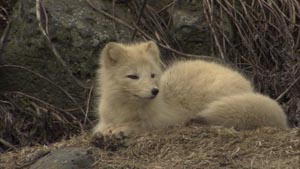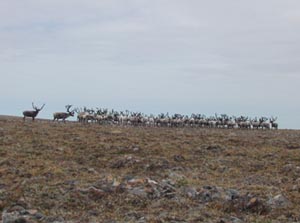
Topics










|
Island Natural Resources
Land Mammals
Only three species of land mammals are considered native to the Pribilof Islands: arctic fox (Alopex pribilofensis), shrew (Sorex pribilofensis), and lemming (Lemmus nigripes) (Preble and McAtee 1923, 102–105, 112). The shrew is found only on St. Paul, and the lemming is found only on St. George. Other land mammals have been introduced or, in the case of the polar bear, visit occasionally. Rats, muskrat, squirrel, and jack rabbits having had the opportunity for introduction did not retain a grip on the islands. Lemmings were unsuccessfully introduced for a third time at St. Paul Island in 1925. The lemmings were released at Lake Hill (Bower 1926, 143).
Arctic Fox
The arctic fox is found on both St. George and St. Paul Islands. Edward Preble and W. L. McAtee (1923) assumed that drift ice originally brought the arctic fox to the islands, where the fox became slightly differentiated from foxes of the mainland. G Dallas Hanna (2008, Chapter IX) wrote about foxes and the fox industry on the Pribilofs:
Normally the species is a beautiful snowy white in winter and on account of its abundance and wide range it does not command a high price on the market. But on these and a few other islands, a melanistic strain predominates and the slate colored pelts are called “blue” in the fur markets. Because of their relative scarcity they command a much higher price than the white. On St. George Island, through selective breeding, the white strain has been almost entirely eliminated, but on St. Paul it still runs about 25 per cent of the total catch. It would be a comparatively easy matter for the animals to reach the islands in winter over the drift ice since they would have but 200 miles to travel in a straight line. They are given to such wanderings and have been observed several miles away from land on the ice floes. And Otter Island seems to have been so stocked from St. Paul Island, many times in the past.
The blue fox is the chief enemy of the breeding birds. This little animal almost defies the laws of gravitation in its scaling of the perpendicular cliffs for bird eggs. The animals jump from ledge to ledge on dizzy heights with a sheer drop of a hundred or a thousand feet below them, many times with an unbroken egg in the mouth.

A white arctic fox (NOAA).
Lemming
While the lemming is found only on St. George Island, purportedly their introduction on St. Paul Island was attempted three times, though none were known to survive. Historically, the St. George Island lemming population fluctuated, being abundant at times and scarce at other times (Osgood et al. 1915, 131; Preble and McAtee 1923, 112).
Shrew
Preble, Hanna, and A. G. Whitney collected early shrew specimens on St. Paul Island, taken primarily from a partially marshy tract bordering a shallow pond between the village and East Landing, but also from Northeast Point (Preble and McAtee 1923, 102). From time to time, shrews may be found in households.
Polar Bear
The polar bear (Ursus maritimus) is a rare visitor to the Pribilof Islands. In the late 1800s and early 1900s, polar bear arrived in conjunction with the ice pack (Preble and McAtee 1923, 103; Ray 1971). They were last recorded on St. George Island in 1915: “These men report seeing bear tracks near the Company House at Zapadni…They lead from the sea line to a place where the animal had apparently laid down and again to where it again took to the water.”31
Reindeer
James Judge and Dr. Warren Evermann of the Bureau of Fisheries, with the cooperation of the Bureau of Education and the Revenue Cutter Service, introduced twenty-five reindeer (Rangifer tarandus) on St. Paul Island and fifteen on St. George Island in 1911 (Hanna 2008, 196). By 1921, there were 250 reindeer on St. Paul Island and 160 reindeer on St. George Island (Preble and McAtee 1923, 115), and by 1938, there were about 2,000 reindeer on St. Paul Island (Thompson 1954). Poaching, harsh winter weather and starvation due to overgrazing of the tundra caused the St. Paul herd to become severely depleted in the 1940s (Scheffer 1951, 356–362; Olson 1951, Thompson 1954). In 1950, only eight reindeer remained at St. Paul Island. Then in 1951, thirty-one reindeer were brought to the island from Nunivak Island (Thompson 1954). The herd died out at St. George by 1953. Several attempts to restock St. George failed until 1980 when at least ten reindeer imported from Umnak Island led to several fawns in 1981. In 2007, several hundred reindeer roam St. Paul and St. George Islands. The reindeer are hunted by permit. The U.S. Department of Agriculture, Natural Resource Conservation Service, with federal, state, and local assistance, has developed a plan for reindeer management on St. Paul Island (USDA undated, ca. 2001).

A herd of reindeer on the Pribilof Islands (NOAA).
House Mouse
Mice were brought to the islands by ships during Russian occupancy (Hanna 2008, 202). Kiril Timofeevich Khlebnikov’s notes stated the mice [he was likely referring to the lemming] were “A small, tailless variety (Pierce 1994, 277). Fur yellowish brown.” Frederick W. True (1899, 345–354) noted that the house mouse was extremely abundant about the City of Saint Paul and had been observed on St. George Island. Today, the house mouse may be found on St. Paul but not St. George.
House mice were introduced on St. Paul before the purchase of the islands in 1867, and in the wild state they have spread from the habitations into the meadows and tundras [sic]. Some of them are white, others have white spots, but the great majority of them are indistinguishable from the well-known household pest of more southern climates. The cats appear to be of absolutely no value in reducing the numbers of the mice. In some inexplicable manner the little rodents have never become established on St. George Island. (Hanna 2008, 201)
Rat
An animal that has not made a home on the Pribilof Islands—the rat—is worthy of special note. Rat introduction would threaten bird and shrew populations and could transfer diseases to humans and wildlife (Sowls and Byrd 2004). Until the early 1990s, the lack of harbors on St. Paul and St. George Islands helped keep the islands free of rats. With the construction of harbors, island entities, government agencies, and industry began a program designed to impede rat introduction. The program consists of trap and poison stations, outreach and education, local shipwreck response capabilities, and regulations (Sowls and Byrd 2004; Sowls et al. 2004). Over a million trap nights have passed and six rats have been killed on the St. Paul docks; yet there is no evidence of rats becoming established anywhere in the Pribilof Islands (Sowls and Byrd 2004).
Jack Rabbit, Squirrel, and Muskrat
During its lease of the Pribilof Islands (1890–1910), the North American Commercial Company attempted an introduction of jack rabbits (Hanna 2008, 194). Its efforts focused on a desire to provide food for blue foxes during the winter season. The same rationale led to attempts to introduce ground squirrels in 1899 and 1913, and presumably muskrat in 1913 (Osgood et al. 1915, 129; Preble and McAtee 1923, 113). The first squirrel introduction occurred near the City of Saint Paul, and the subsequent disappearance of the animal was attributed to cats, though possibly foxes played a hand. The second squirrel introduction involved the release of five animals near the City of Saint George. Two were known to survive the winter but were not seen again. A single muskrat, the only one of seven shipped not to become the prey of its own species during transit, was released in a pond near the City of Saint George; it did not survive (Preble and McAtee 1923, 113). Preble commented on such introductions in 1914: “The abnormally crowded condition of the fox life on the Pribilofs has a sinister bearing on the practicability of adding to their food resources by introducing small mammals among them.”(Preble et al. 1916, 129)
Geology
Flora
Marine Mammals
Domestic Animals
Birds
Marine Invertebrates
Insects and Arachnids
Fossils
|


